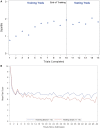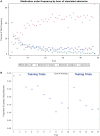Learning optimal opioid prescribing and monitoring: a simulation study of medical residents
- PMID: 31984336
- PMCID: PMC6951957
- DOI: 10.1093/jamiaopen/ooy026
Learning optimal opioid prescribing and monitoring: a simulation study of medical residents
Abstract
Objective: Hospitalized patients often receive opioids. There is a lack of consensus regarding evidence-based guidelines or training programs for effective management of pain in the hospital. We investigated the viability of using an Internet-based opioid dosing simulator to teach residents appropriate use of opioids to treat and manage acute pain.
Materials and methods: We used a prospective, longitudinal design to evaluate the effects of simulator training. In face-to-face didactic sessions, we taught 120 (108 internal medicine and 12 family medicine) residents principles of pain management and how to use the simulator. Each trainee completed 10 training and, subsequently, 5 testing trials on the simulator. For each trial, we collected medications, doses, routes and times of administration, pain scores, and a summary score. We used mixed-effects regression models to assess the impact of simulation training on simulation performance scores, variability in pain score trajectories, appropriate use of short- and long-acting opioids, and use of naloxone.
Results: Trainees completed 1582 simulation trials (M = 13.2, SD = 6.8), with sustained improvements in their simulated pain management practices. Over time, trainees improved their overall simulated pain management scores (b = 0.05, P < .01), generated lower pain score trajectories with less variability (b = -0.02, P < .01), switched more rapidly from short-acting to long-acting agents (b = -0.50, P < .01), and used naloxone less often (b = -0.10, P < .01).
Discussion and conclusions: Trainees translated their understanding of didactically presented principles of pain management to their performance on simulated patient cases. Simulation-based training presents an opportunity for improving opioid-based inpatient acute pain management.
Keywords: pain management; patient safety; simulation; training.
© The Author(s) 2018. Published by Oxford University Press on behalf of the American Medical Informatics Association.
Figures




References
-
- Abbott FV, Gray-Donald K, Sewitch MJ, Johnston CC, Edgar L, Jeans ME.. The prevalence of pain in hospitalized patients and resolution over six months. Pain 1992; 501: 15–28. - PubMed
-
- Marks RM, Sachar EJ.. Undertreatment of medical inpatients with narcotic analgesics. Ann Intern Med 1973; 782: 173–81. - PubMed
-
- Centers for Disease Control and Prevention. Prescription drug overdoses-A us epidemic. MMWR Morb Mortal Wkly Rep 2012; 61: 10–3. - PubMed
Grants and funding
LinkOut - more resources
Full Text Sources
